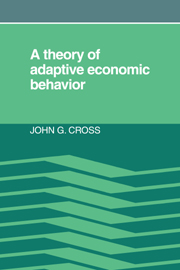Book contents
- Frontmatter
- Contents
- Preface
- 1 Introduction
- 2 Models of convergence
- 3 Behavior in the short run
- 4 Uncertainty
- 5 An application to state lottery games
- 6 An application to the problem of search behavior
- 7 Inflationary disequilibrium
- 8 Advertising and imitation
- 9 An application to migration
- 10 Conclusions
- References
- Index
7 - Inflationary disequilibrium
Published online by Cambridge University Press: 07 October 2011
- Frontmatter
- Contents
- Preface
- 1 Introduction
- 2 Models of convergence
- 3 Behavior in the short run
- 4 Uncertainty
- 5 An application to state lottery games
- 6 An application to the problem of search behavior
- 7 Inflationary disequilibrium
- 8 Advertising and imitation
- 9 An application to migration
- 10 Conclusions
- References
- Index
Summary
For our third application of the general feedback theory, we develop a model of asymmetric price behavior in an economy. It is often alleged that prices and wages are influenced by “ratchet” mechanisms whereby certain prices can be readily induced to rise but display considerable resistance to downward pressures. The reluctance of trade unions to accept downward revisions in wage rates is often cited as an example of this phenomenon. Recently, a number of economists (Vining and Elwertowski, 1976; Parks, 1978) have noticed the existence of a positive association between the mean rate of inflation (or, in Parks's version, a proposed measure of the rate of unexpected inflation) and the variance of individual price changes around this mean. The most common argument is that high rates of inflation are responsible for instability in relative prices, and Parks, in particular, has outlined a number of theories to that effect. The data, however, are equally consistent with a reversal in the direction of causality, in which disequilibrium in individual markets is considered to be responsible for inflation, through the proposed ratchet mechanism.
It is difficult to find any convincing theoretical underpinning in rational behavior for this ratchet, however. Even in the frequently cited case of the labor union, it is not clear why the asymmetric price behavior would be in the self-interest of workers. (Why not simply seek as high a wage as possible in any period?) This being the case, it is well worthwhile to exploit the fact that feedback processes are well defined for disequilibrium and look for some source of asymmetry within this mechanism.
- Type
- Chapter
- Information
- A Theory of Adaptive Economic Behavior , pp. 131 - 150Publisher: Cambridge University PressPrint publication year: 1983



